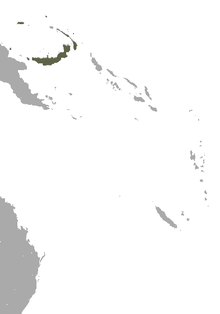Andersen's naked-backed fruit bat
Andersen's naked-backed fruit bat or Andersen's bare-backed fruit bat (Dobsonia anderseni) is a large cave-dwelling species of megabat in the family Pteropodidae. It is endemic to the Bismarck Archipelago including the Admiralty Islands in Papua New Guinea.
| Andersen's naked-backed fruit bat | |
|---|---|
| Scientific classification | |
| Kingdom: | Animalia |
| Phylum: | Chordata |
| Class: | Mammalia |
| Order: | Chiroptera |
| Family: | Pteropodidae |
| Genus: | Dobsonia |
| Species: | D. anderseni |
| Binomial name | |
| Dobsonia anderseni Thomas, 1914 | |
 | |
| Andersen's naked-backed fruit bat range | |
Taxonomy and etymology
It was described as a new species in 1914 by British zoologist Oldfield Thomas. The holotype used to described the species had been collected by Albert Stewart Meek and his brother-in-law, Albert Frederic Eichhorn, in October 1913. The eponym for the species name "anderseni" is Danish mammalogist Knud Andersen. Of Andersen, Thomas wrote: "I have named the species in honour of Dr. K. Andersen, in recognition of the striking monograph of Dobsonia contained in his Catalogue, a monograph which has entirely revolutionized our knowledge of the group."[2]
Description
Its forearm length is 123–125 mm (4.8–4.9 in). Its fur is very dark brown, with its head nearly black.[2]
Range and habitat
Its range includes several islands of Papua New Guinea. It has been documented at elevations up to 1,500 m (4,900 ft) above sea level.[1]
Conservation
As of 2008, it is listed as a least-concern species by the IUCN. It meets the criteria for this classification because it has a wide geographic range; its population is presumably large; it tolerates a degree of habitat disturbance; and its population trend appears to be stable or increasing. Threats to this species include overharvesting for bushmeat or disturbance of the caves where it roosts during the day.[1]
References
- Helgen, K.; Allison, A.; Bonaccorso, F.; Hamilton, S. (2008). "Dobsonia anderseni". The IUCN Red List of Threatened Species. 2008: e.T136374A4282621. doi:10.2305/IUCN.UK.2008.RLTS.T136374A4282621.en.
- Thomas, O. (1914). "XLIX.—On mammals from Manus Island Admiralty group, and Ruk Island, Bismarck Archipelago". Journal of Natural History. 8. 13 (76): 435–436. doi:10.1080/00222931408693505.
